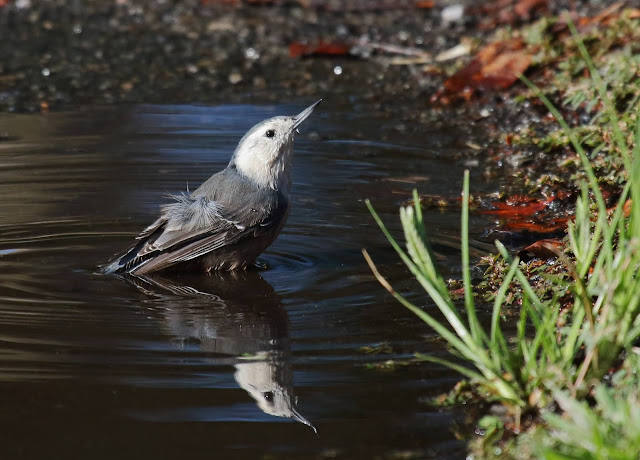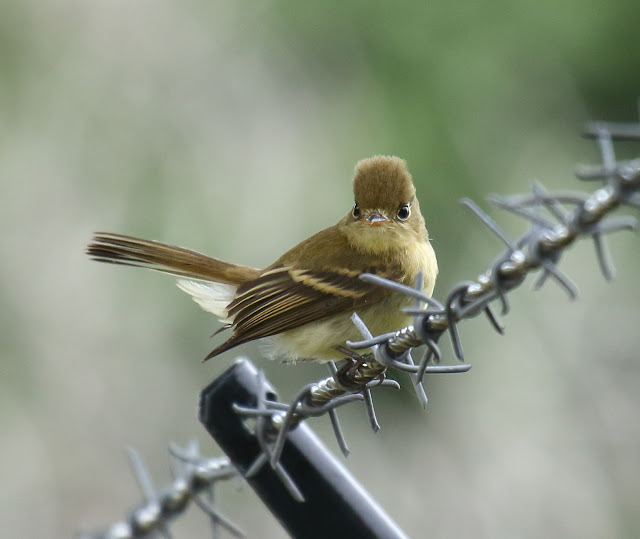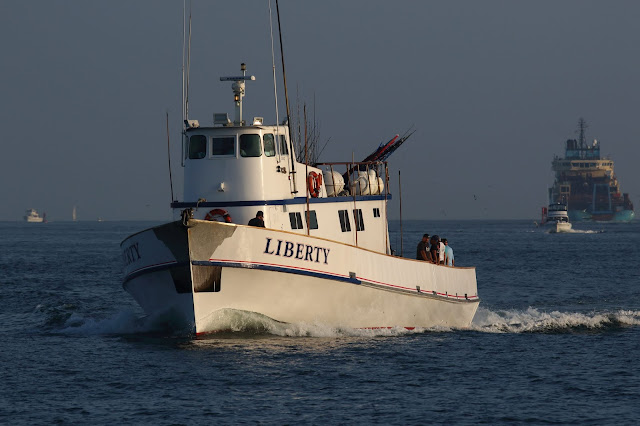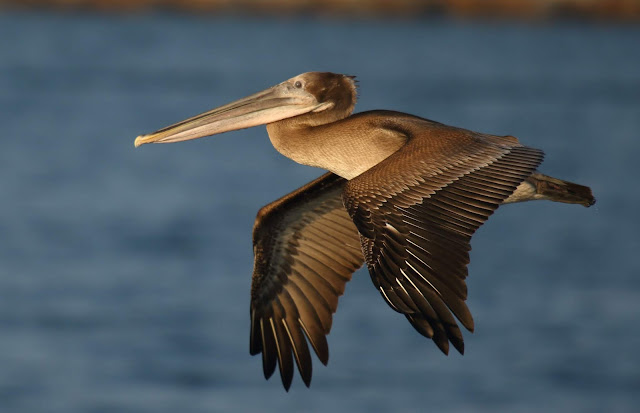My new camera (Canon EOS 7D Mark II) has much better autofocus and ISO range than my previous Canon Digital Rebel XTi (bought in 2006). I've mentioned before that the XTi never had enough light with my 100-400mm zoom lens to use ISO 100, and that ISO 1600 was so grainy (digital noise--especially in shadows) I never used it. So I customarily set the ISO at 400 and aperture at f/7.1 and left it there, letting the camera choose the shutter speed.
On the other hand, the 7D Mark II has infinite ISO. Okay, so it's not infinite, but rather than 1600 it goes to 16000! And it even goes beyond that with special settings that I don't know why you'd use unless taking really grainy photos in near blackness.
I have learned to shoot Manual mode recently and often shoot Manual with Auto-ISO, at 1/1250 sec, f/7.1 @ 400mm as a default "birding" setting, as long as light is sufficient. For more active or flying birds a shutter from 1/2000 to 1/4000 sec stops motion as light permits.
However, when shooting "birds in the bush," hopping from sun to shade or backlit by bright skies, I use different settings.
Autofocus
There are a huge number of Autofocus settings on my camera. But for getting pinpoint focus through the branches on the face or even the eye, I use the Spot AF setting. It is smaller than the default single Autofocus point. I use this setting nearly always. Some of the other AF point selection modes are theoretically "better" for focusing, but I haven't found it to be so, at least on my present lens, which is the old Canon 100-400mm f/4.5-5.6 L IS. This lens is a bit soft in focus. The new lens in this series is supposedly much sharper. But as long as my present lens works I cannot afford to upgrade. Now that I can take 10 frames per second I am able to get some sharper, some fuzzier, in a burst.
Metering
For general bird photography the Evaluative Metering mode is ideal. The Evaluative mode takes into account the entire frame but is weighted more to the center. In RAW you can adjust the color temperature and restore the warm sunny tones you observed. So you don't mess with white balance in the field when shooting RAW.
In recent weeks, however, I've been shooting warblers in the trees against the backlit skies or in dense bushes under a cloudy marine layer and in shade. Jumping from over-bright to over-dark is very difficult--especially if you're chasing warblers through the foliage. If your subject bird takes up at least 15% of the frame width then you can use Spot Metering. In this case your bird is exposed properly even if the background sky is blown out, or the background shadows go to black. It's tricky though, especially for black-and-white birds, or if the bird isn't quite large enough so that you hit part of the bird and part of the background. So frame-to-frame shots may all be exposed slightly differently, depending upon how steadily you hold the focus on the exact spot on the bird. I would not use this Spot Metering mode on a pelagic trip, for instance, where the bird is too small in frame and there the bouncing of the boat, waves, and flying of the bird means that I can't hold steady.
So, I am still shooting Manual with the shutter speeds and aperture that allows me to get good photos with Auto-ISO. Shoot green grass in the open to give you an idea of proper Manual mode shutter, aperture, and ISO settings. Then set shutter and aperture as the green grass would indicate. Set Auto-ISO. Set Spot AF and Spot Metering.
This won't make artistic photographs. But it will give you properly exposed birds for documentation photos, even if the noise is severe. Noise can be smoothed when rendering your RAW files.
The photos below discuss shots of birds on September 16 and 21 of 2018 at Buddy Todd Park in Oceanside, California.
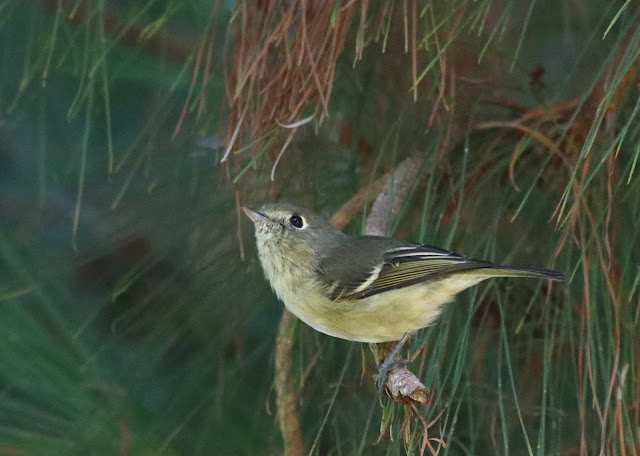 |
Hutton's Vireo in deep shade. 1/1250 sec, f/7.1 @400mm, ISO 10000.
It's grainy, but still usable.
|
 |
Red-eyed Vireo against bright sky. 1/1250 sec, f/7.1 @400mm, ISO 2500.
Evaluative metering would have turned the sky gray and the bird very dark.
|
 |
Black Phoebe and background in nice even light. 1/800 sec, f/7.1 @400mm, ISO 500.
Evaluative metering would have worked "better" but this came out perfect with Spot metering.
|
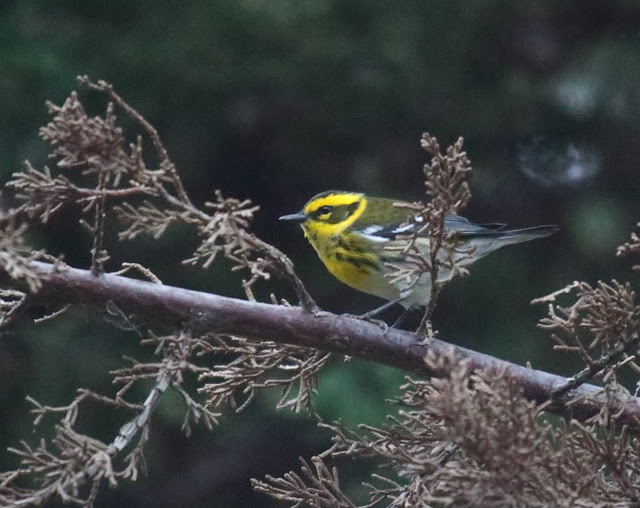 |
Townsend's Warbler in deep shade. 1/400 sec, f/5.6 @400mm, ISO 16000.
This is as shady a condition as one could obtain a sharply focused bird with my image stabilized lens.
|
 |
Nuttall's Woodpecker strongly backlit. 1/640 sec, f/5.6 @400mm, ISO 2000.
If Evaluative metering had been used the sky would have been gray and the bird and tree trunk black.
|
 |
Western Tanager in front of deep shadows. 1/1250 sec, f/5.6 @400mm, ISO 4000.
If Evaluative metering had been used the yellow parts of the bird would have been blown out.
|
 |
Allen's Hummingbird in shade. 1/1250 sec, f/7.1 @400mm, ISO 8000.
Evaluative mode would have turned the bird dark to compensate for some foliage in the light (cropped out).
|











